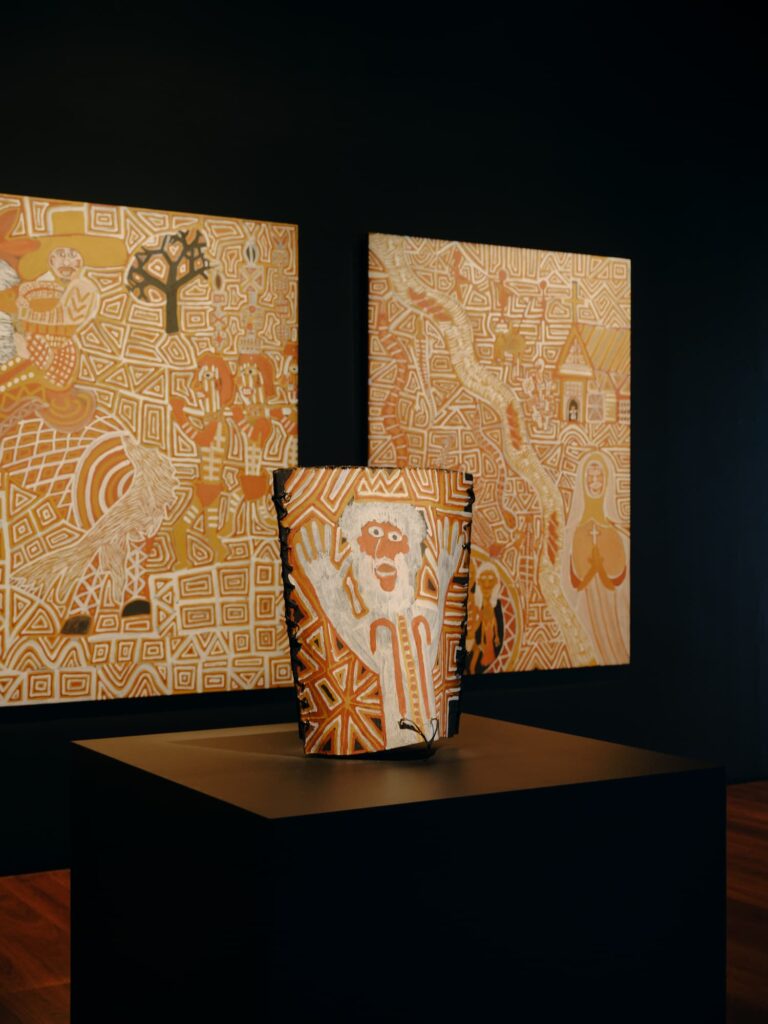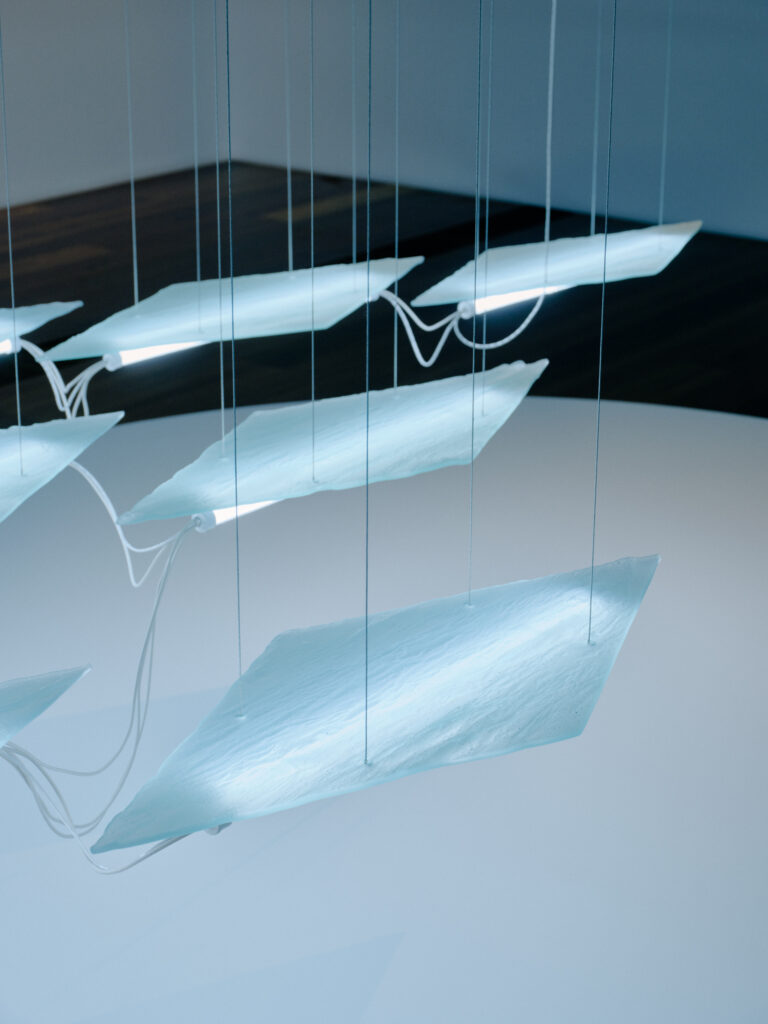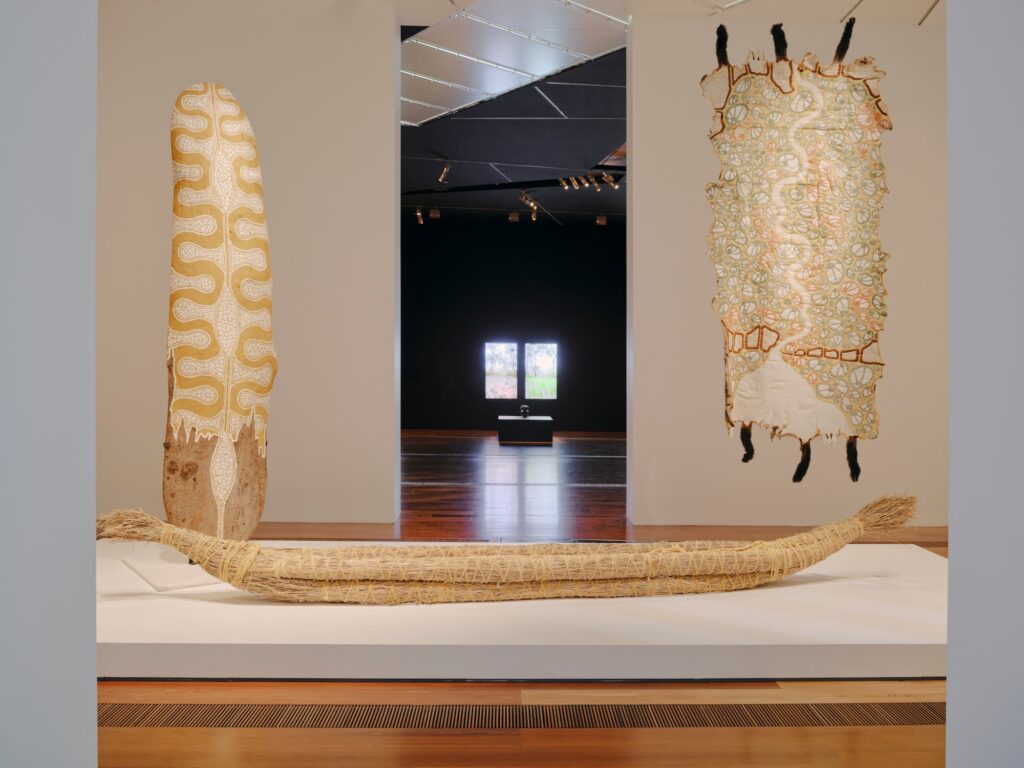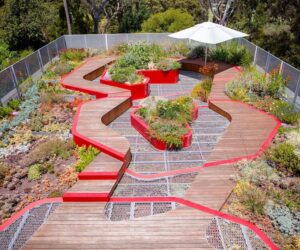My Country: Country Road + NGV First Nations Commissions Unveils New Works by Emerging First Nations Artists
As part of the landmark Country Road + NGV First Nations Commissions, eight emerging First Nations artists are presenting ambitious new works in the exhibition My Country, which opened 22 March 2024 at The Ian Potter Centre: NGV Australia. The first and only initiative of its kind, the Country Road + NGV First Nations Commissions is a national, biennial mentorship program and exhibition series that invites an artist from every state and territory to produce a significant new work under the guidance of an esteemed mentor.
A testament to national scope of this initiative and diversity of practices represented, outcomes range from textiles, customary cultural objects and large scale paintings to installations that engage glass making and new modes of fabrication.
Invited by the NGV to participate in the commission series, the mentors nominated an emerging artist for the commission opportunity which includes guidance through the conception, creation and delivery of a major work over the year long mentorship.
Working out of Iwantja Arts in Indulkana, South Australia, Alec Baker and Eric Barney have produced two large collaborative paintings, titled Ngura (Country), that are as rich in their hues of red, pink, orange and yellow as they are in their embodiment of sacred stories and customs. Barney is an emerging artist who paints under the cultural mentorship of senior lawman and founding Iwantja Arts artist Baker. The works reflect the beauty of Yankunytjatjara Country in the Anangu Pitjantjatjara Yankunytjatjara (APY) Lands depicting rocky hills, waterholes, animals tracks and Tjukurrpa (ancestral stories) of women. The artists are mentored by 2019 Ramsay Art Prize winner and the first Indigenous artist to be awarded the Archibald Prize, Vincent Namatjira OAM.
Tiwi artist Johnathon World Peace Bush, also widely known as Jon Jon, has produced a body of work that tells of Tiwi culture, storytelling and history. Mentored by his cousin Pedro Wonaeamirri, their shared ancestry and Country are at the heart of this mentorship. Working out of Jilamara Arts, Melville Island, on Wulirankuwu Country, Jon Jon has created three paintings that depict stories of his and Wonaeamirri’s grandfather and father’s life and subsequent displacement from Murrakupupuni (Country) of Paluwiyanga (Goose Creek). Jon Jon has also created two collaborative works with Wonaeamirri, a tunga (folded stringybark ceremonial basket) made by Wonaeamirri that Jon Jon painted with ochre, and a is a video work filmed on Country that shows Jon Jon dancing his totem tartuwali (shark) as Wonaeamirri sings.
Jan Baljagil Gunjaka Griffiths‘s work Tree of knowledge, which depicts the native gerdewoon (boab tree), is made of ceramic hand-painted boab nuts, a four-metre-high ochre on paper painting of a gerdewoon and a soundscape of Griffith’s poetry. The work honours the personal and cultural significance of the gerdewoon as a source of food, water, cultural stories and as a historical site. Griffiths has been mentored by her mother and senior artist Peggy Griffiths, both are Miriwoong women from Kununurra in the East Kimberley, Western Australia working out of Waringarri Arts.
For Canberra-based artist and Walgalu and Wiradjuri man Aidan Hartshorn the commission was an opportunity to pursue new mediums in his practice and build upon his ongoing Masters research into the impact of the Snowy Mountains Scheme on Walgalu Country. Mentored by Nunga (Kaurna Miyurna) and Māori (Te Arawa) man James Tylor, Hartshorn has created an installation comprised of sixteen individual diamond-shaped glass shields reflecting traditional Wiradjuri bark shields – each representing one of the dams of the Snowy Hydro. By suspending the shields in the formation of the now-hidden Tumut River and illuminating them with blades of white light, Hartshorn’s work gestures to the implications of the hydroelectricity system on Walgalu Country and cultural sites.
Gamilaroi weaver and textile artist Sophie Honess has produced three woven rugs titled Daruka – grass, water, granite. Over 86,000 wool knots make up Honess’s work which represents Daruka, a site of great significance for the artist and her community located on Gamilaroi Country (Tamworth, New South Wales). The rugs each reflect different environmental features of Daruka – the grasses, creek beds and sand. For the commission, Honess was mentored by Wiradjuri and Kamilaroi man and contemporary artist, Jonathan Jones. Honess also spent time on Country with knowledge holder Marc Sutherland and cultural mentor Amy Hammond to deepen her understanding and develop a visual language of Gamilaroi Country.
Boonwurrung and Barkindji man, Mitch Mahoney has created two bark canoes, a red gum canoe and a river reed canoe, and was guided through proper cultural processes and protocols by Barkindji artist David Doyle including learning collecting bark for the canoe and healing the tree with mud. Focusing on cultural revitalisation, the artist has also made a possum skin cloak honouring his mother’s culture which he learned over years working with his mentor and aunt Mutti Mutti, Yorta Yorta and Boonwurrung / Wemba Wemba woman Maree Clarke.
Cheryl Rose, a Pataway-based (Burnie, Tasmania) multimedia artist, explores the fragmented stories of her Country, culture and community through a wall-based installation titled Fragments. The large-scale work on Japanese Kozo paper features hand-rendered images of caves at Pinmatik (Rocky Cape) and cultural tools that were historically removed from the site and subsequently archived at the Tasmanian Museum and Art Gallery. The work incorporates an audiovisual component, developed with digital artist Darryl Rogers, evoking sounds and atmosphere around Pinmatik. Rose has been mentored by Denise Robinson who she has worked on projects with for 15 years, and both are descendants of the Trawlwoolway people.
Brisbane-based Kamilaroi man Warraba Weatherall is mentored by Girramay/ Yidinji / Kuku Yalanji man Tony Albert. His new work builds on his PhD research into the impact of systems of colonial bureaucracy and linguicide on contemporary society. For the commission Weatherall has fabricated a custom polyphon (a large disc-operated music player) which plays a musical composition created by translating oppressive archival documents into braille. Titled Dirge the steel polyphon implicates the body through sound, and questions why invisible colonial systems and forms, such as monuments, are reflexively accepted.
Tony Ellwood AM, Director, NGV, said: ‘The Country Road + NGV First Nations Commissions creates a major new platform for First Nations art and design in Australia. The unique mentorship format – the only one of its kind in Australia – offers career-defining opportunity to emerging practitioners to create a new work under the guidance of a mentor.’
‘We’re grateful for the support of Country Road for this important new initiative. This mentorship program has enabled NGV to cultivate important new relationships with First Nations practitioners across the country. With the eight works entering the NGV Collection, this commission will enhance our ability to represent and profile our rich and diverse Indigenous communities,’ said Ellwood.
Myles Russell-Cook, Senior Curator, Australian and First Nations Art, NGV said: ‘Initiatives like this are vitally important. For many First Nations people, the concept of intergenerational knowledge transfer is at the heart of how we live our lives. For artists, mentoring is a way of giving back. Mentorship is something that motivates us; it is about respecting the knowledge of those who have come before us, and making space for those who will come afterwards.’
Elle Roseby, Managing Director, Country Road, said: ‘This program presents an incredible opportunity to further our work in supporting First Nations communities, in a first-of-its-kind partnership that is led by First Nations artists. We’re thrilled to be working together with the NGV to platform inspiring creatives across the country, while celebrating their stories and increasing the recognition of First Nations cultures, histories and knowledge.’
My Country: Country Road + NGV First Nations Commissions will be on display 22 March – 4 August 2024 at The Ian Potter Centre: NGV Australia, Fed Square, Melbourne.
For further information, please visit the NGV website: NGV.MELBOURNE









